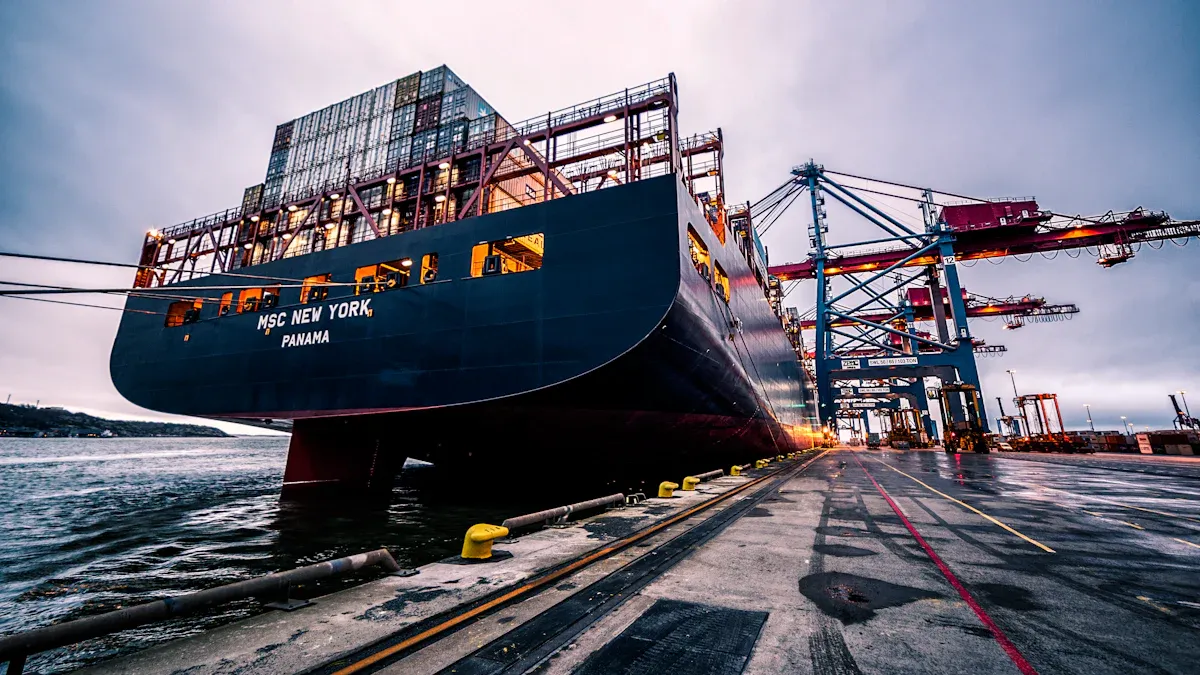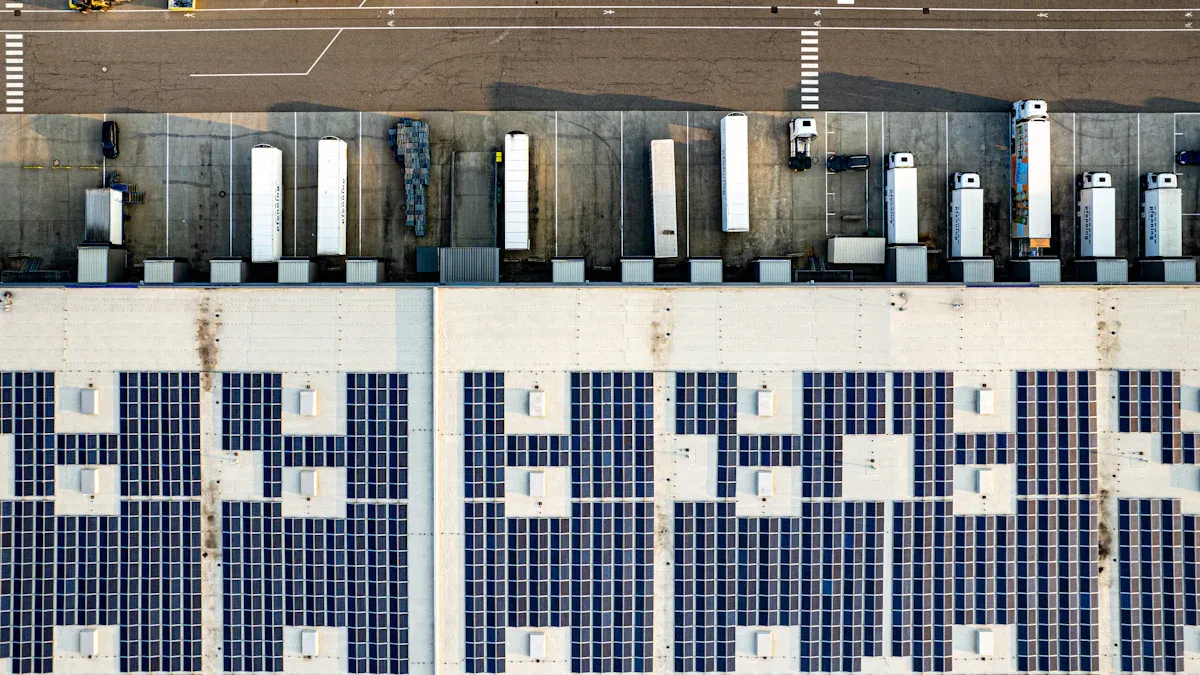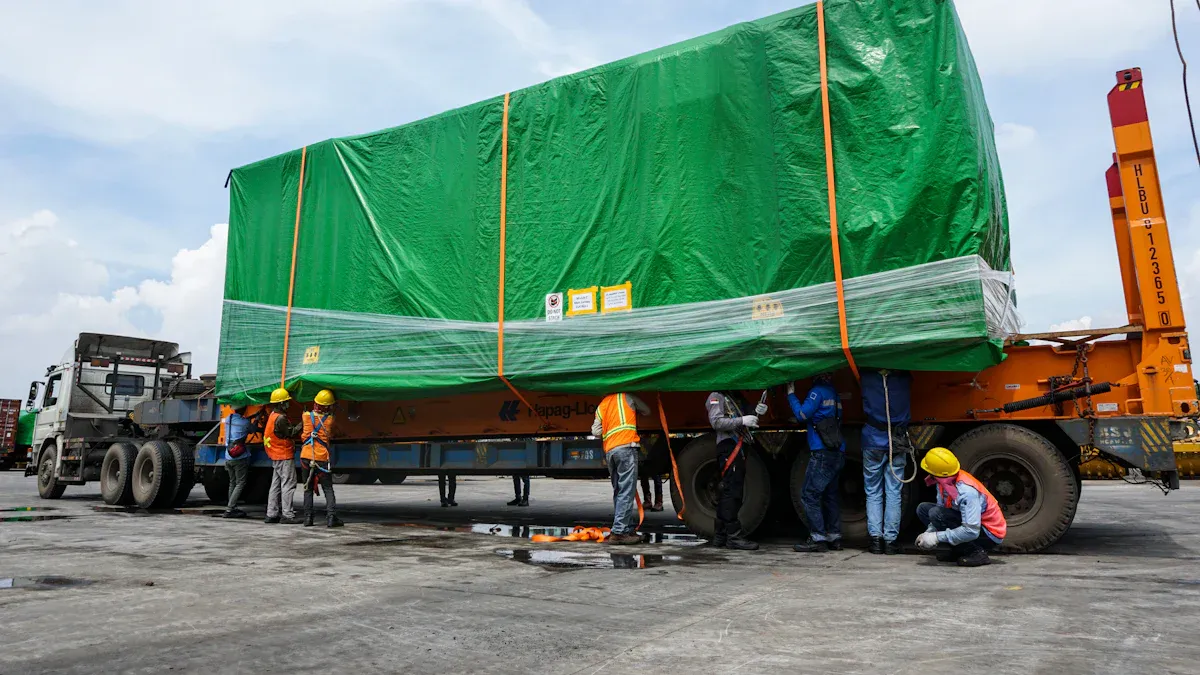What Is Energy Supply Chain Management and Why Is It Important

Energy supply chain management means you oversee the journey of energy from where people produce it to where you use it. You make sure energy moves smoothly and reaches people when they need it. Good management keeps costs low, helps protect the environment, and ensures you always have power. You also reduce risks and help everyone involved work better together.
Key Takeaways
Energy supply chain management ensures energy moves smoothly from production to consumption, keeping costs low and reliability high.
Effective management reduces risks from disruptions like bad weather or cyberattacks, ensuring energy is delivered safely and on time.
Sustainability is key; using cleaner energy sources and efficient practices helps protect the environment and lower costs.
Technology plays a vital role in improving efficiency, with tools like sensors and analytics helping to monitor and manage energy use.
Building strong partnerships and local sourcing enhances resilience, making the energy supply chain more flexible and responsive to challenges.
Energy Supply Chain Management Overview

What It Means
You manage the flow of energy from where people find it to where you use it. Energy supply chain management covers every step, starting with raw materials and ending with the final use. You see how energy moves from oil fields, wind farms, or solar panels to homes, schools, and businesses. This process includes finding resources, turning them into usable energy, and making sure they reach you safely and on time.
The main objective of supply chain management is to stimulate sales, minimize costs, and fully leverage business assets by enhancing collaboration and communication among all stakeholders in the supply chain.
You use energy supply chain management to keep everything running smoothly. You help companies lower costs and improve teamwork. You also make sure energy gets delivered without delays or waste.
Key Stages
Energy supply chain management involves several important stages. Each stage plays a role in making sure energy reaches you efficiently.
Stage | Description |
|---|---|
You find and extract energy resources from the earth, such as fossil fuels or renewables. | |
2. Transportation | You move energy resources to places where people need them, using pipelines, ships, or power lines. |
3. Refining and Processing | You turn raw energy into usable forms like electricity or fuel. |
4. Distribution | You deliver energy products to homes, businesses, and factories. |
5. Consumption | You use energy in daily life, which affects the environment and the economy. |
You can see these stages in many types of energy. Oil and gas often travel long distances before you use them. Renewable energy, like solar or wind, is usually produced closer to where you live. Renewable projects face special challenges, such as supply chain bottlenecks and cost changes. You need to upgrade grids and add energy storage to handle renewables. Companies also work to control emissions and use cleaner technology.
Here are the main processes you find in energy supply chain management:
Sourcing: You choose suppliers for raw materials.
Making: You transform raw materials into finished energy products.
Delivery: You send finished products to end-users.
Returning: You handle returns, repairs, recycling, or disposal.
Integration of Participants
You improve energy supply chain management by helping everyone work together. When you connect producers, suppliers, transporters, and customers, you make operations faster and information clearer. You use different strategies to manage risks and boost efficiency.
Strategy Type | Risk Level | Effectiveness |
|---|---|---|
Low-risk | Works well when risks are low | |
Substitution strategy | High-risk | Best for high-risk situations |
SENDEA model | N/A | Helps evaluate blockchain adoption |
Principal Component Analysis (PCA) | N/A | Assesses blockchain strategies |
You also see models that help companies choose better suppliers and reduce energy use. For example, some studies show that using renewable energy can lower carbon emissions and costs. Other research finds that most energy use happens in the early stages of the supply chain. Companies use special tools to measure how suppliers perform and make decisions that help the environment.
Tip: When you integrate all participants, you streamline operations and improve communication. This leads to better results for everyone in the energy sector.
Importance in the Energy Sector
Reliability and Risk Management
You depend on energy every day, so reliable delivery matters. Energy supply chain management helps you get energy on time and at the right quality. When you manage the supply chain well, you avoid delays and shortages. You also keep costs under control and make sure energy is safe to use.
Many risks can disrupt the energy supply. These risks include bad weather, cyberattacks, and political problems. If a hurricane damages power lines or a cyberattack hits a power plant, you might lose access to energy. You can lower these risks by planning ahead and working with others in the supply chain.
Here are some ways you can improve reliability and manage risks:
Flexible sourcing contracts help you keep a steady supply, even if one source fails. Companies like Honda and Toyota use this method.
Inventory reserves let you handle sudden problems without running out of energy.
Working closely with suppliers helps you recover faster from disruptions.
Technology, like smart sensors, helps you spot problems early and fix them quickly.
Diversifying your resources makes your supply chain stronger against threats.
Note: Supply chain disruptions can cause energy shortages and economic losses. You need to watch out for climate events, cyber threats, and political tensions. These risks are growing and can affect how you get your energy.
Cost Efficiency
You want energy that is both reliable and affordable. Good supply chain management helps you control costs and avoid waste. When you manage costs well, you can invest in better equipment and new projects.
Here is a table showing how cost efficiency affects energy supply chains:
Description | Impact on Performance |
|---|---|
Reliability drops, making it harder for you to get energy when you need it. | |
Rising material and labor costs | New projects slow down, and existing operations face more challenges. |
Scope 3 emissions are over 80% of energy use in supply chains | Hard-to-track emissions make it tough to improve efficiency and sustainability. |
You can save money by using energy-efficient technology and better planning. For example, smart sensors and LED lighting help you use less energy. Fuel-efficient trucks and electric vehicles lower transportation costs and reduce pollution. When you use resources wisely, you spend less and help the environment.
Sustainability Goals
You play a part in protecting the planet. Energy supply chain management supports your efforts to use cleaner energy and cut down on pollution. Most emissions in the energy sector come from the supply chain, not just from using energy.
Supply chains produce greenhouse gases that are 11.4 times higher than emissions from daily operations.
For many companies, supply chain emissions make up over 70% of their total carbon footprint.
About 40% of firms track their direct emissions, but fewer watch their supply chain emissions.
Many companies lack enough data from suppliers to measure their impact on the environment.
You can help by choosing energy-efficient products and supporting companies that use clean energy. Using LED lights, smart sensors, and electric vehicles reduces energy use. Switching to renewable energy and electrifying heavy operations also cuts down on fossil fuels.
Tip: When you focus on sustainability, you lower costs, reduce waste, and protect the environment for future generations.
Challenges and Solutions

Common Challenges
You face many challenges in the energy supply chain. Extreme weather can damage infrastructure and stop deliveries. Rising transportation costs make it harder to move energy where it is needed. Cybersecurity threats put your systems at risk. Tariffs and economic uncertainty can change the price and availability of materials. Labor shortages slow down operations. More people want sustainable practices, which adds pressure to improve.
Challenge | Description |
|---|---|
Extreme Weather | Increased frequency and severity of weather-related disruptions affecting supply chains. |
Rising Transportation Costs | Fluctuating freight costs due to various factors impacting the ability to meet customer demand. |
Cybersecurity Threats | Significant risks from cyberattacks, with a notable increase in incidents affecting supply chains. |
Tariffs and Economic Uncertainty | New tariffs affecting raw material sources and product availability in retail. |
Labor Shortages | High labor shortages impacting customer service and transportation operations. |
Sustainability Demands | Growing need for sustainable practices in supply chain operations. |
You also see how rising material costs and logistics problems can cause:
Reduced supply and increased demand, leading to higher prices.
Higher transportation costs, which get passed on to you.
Reduced production capacity, making energy less available.
Increased uncertainty and speculation, causing price swings.
Strategic Solutions
You can use several strategies to overcome these challenges:
Combine local market knowledge with global approaches. This helps you innovate and deliver projects faster.
Invest in local supply chains. Sourcing materials nearby lowers transportation costs and builds resilience. For example, a wind farm in Alberta created 150 local jobs by using local suppliers.
Build strong supplier relationships. Long-term partnerships improve communication and flexibility, helping you get parts even during disruptions.
Use advanced technologies like predictive analytics and AI. These tools help you spot problems early and manage inventory better.
Tip: When you use these strategies, you make your supply chain stronger and more flexible.
Technology and Innovation
Technology helps you solve many supply chain problems. Big data analytics improves predictability and management. Blockchain increases transparency and traceability. The Internet of Things (IoT) lets you monitor equipment in real time and predict failures. Additive manufacturing supports customization and reduces waste.
Technology | Impact on Resilience and Efficiency |
|---|---|
Big Data Analytics | Enhances predictability and optimizes supply chain management. |
Blockchain | Improves transparency and traceability in supply chains. |
Internet of Things (IoT) | Facilitates real-time monitoring and predictive maintenance. |
Additive Manufacturing | Supports customization and reduces waste in production processes. |
You also see new innovations like AI-driven supply chains, advanced robotics, and early engagement with project partners. These tools help you forecast demand, track products, and automate tasks, making your supply chain more efficient and reliable.
Future Trends
Renewables and Decentralization
You see a big shift toward renewable energy and decentralized systems. This change moves away from large, central power plants to smaller, local sources. Local energy production helps your community become more resilient and efficient. Microgrids can work on their own, so you still have power during outages. Decentralized systems also lower the risk of big blackouts and make it easier to recover from disasters.
The 21st century marks a shift towards decentralized and intermittent energy sources, transitioning from a 'hub and spoke' model to a more distributed network.
Here are some key benefits of decentralization:
Local energy production boosts resilience and sparks new ideas.
You use less energy moving power over long distances.
Communities gain more control and can try new technologies.
You also notice new trends in renewable energy supply chains:
Trend | Description |
|---|---|
Supply Chain Agility | You need flexible sourcing and local suppliers to handle rising costs and risks. |
Uncertain Policies | Short-term political changes can affect investments in renewables. |
Shaky Supply Chain | Supply and demand for solar and wind parts do not always match, causing delays. |
Digitalization
Digital tools are changing how you manage energy. You use sensors, smart meters, and software to track energy use and spot problems early. Digital transformation helps you use assets better and match supply with demand. You also cut costs and reduce waste.
Digital tools make your supply chain faster and more reliable.
You can see where energy goes and fix issues quickly.
Digital twins let you test changes before making them in real life.
Benefit/Challenge | Description |
|---|---|
Improved Forecasting | You monitor and analyze systems in real time for better planning. |
Predictive Maintenance | You fix problems before they cause downtime. |
Enhanced Energy Efficiency | You find ways to use less energy and save money. |
High-Quality Data Requirement | You need good data for digital tools to work well. |
Integration Complexities | Old systems can be hard to connect with new digital tools. |
ESG and Circular Economy
You now see companies focus more on ESG (Environmental, Social, and Governance) and circular economy practices. These efforts help you make supply chains cleaner, fairer, and more efficient.
ESG rules mean you must track where products come from and how they are made.
You need to make sure your supply chain is ethical and sustainable.
Companies train suppliers and work with local groups to improve standards.
Key Findings | Description |
|---|---|
Increasing Attention | More companies focus on circular economy practices. |
Renewable Energy & Resource Efficiency | You use more renewables and try to waste less. |
Institutional Pressures | Rules and expectations push you to adopt better practices. |
Tip: When you support ESG and circular economy goals, you help protect the planet and build a stronger community.
You see how energy supply chain management shapes your daily life and supports your community. Strong supply chains help you get reliable energy, protect the environment, and build local jobs. Recent case studies show you need to plan for resilience, use digital tools, and work with trusted partners:
Treat supply chain planning as a key business strategy.
Prepare for many types of disruptions.
Use digital transformation for better forecasting.
Build strong partnerships.
Focus on sustainability and local solutions.
When you stay informed about new strategies, you help your community and the planet. You can support local sourcing, training programs, and community engagement.
Evidence Type | Description |
|---|---|
Social Constructions | New frameworks improve sustainability and engagement. |
Resilience Energy Management | Flexible solutions keep energy flowing. |
Supply Chain Energy Management | Efficiency and climate neutrality matter. |
You can follow trends like domestic manufacturing and traceability.
You help create a future with clean, reliable energy for everyone.
FAQ
What is the main goal of energy supply chain management?
You want to make sure energy moves from where people produce it to where you use it. The main goal is to deliver energy safely, on time, and at the lowest cost.
How does technology help the energy supply chain?
You use technology like sensors and software to track energy, spot problems, and plan better. Technology helps you save money, reduce waste, and keep energy flowing.
Why is sustainability important in energy supply chains?
You help protect the planet by using less energy and choosing cleaner sources. Sustainable supply chains lower pollution and support a healthier environment for everyone.
What risks can disrupt the energy supply chain?
You face risks like bad weather, cyberattacks, and rising costs. These risks can stop energy from reaching you. Planning and teamwork help you handle these problems.
See Also
Simplifying Supply Chain Management With American Logistics Solutions
Connecting Warehouses For Efficient Supply Chain Management
Key Strategies For Effective Global Logistics Operations
The Role Of Point-to-Point Systems In Global Logistics
PGL’s Knowledge Ensures Smooth Operations In U.S. Supply Chains
